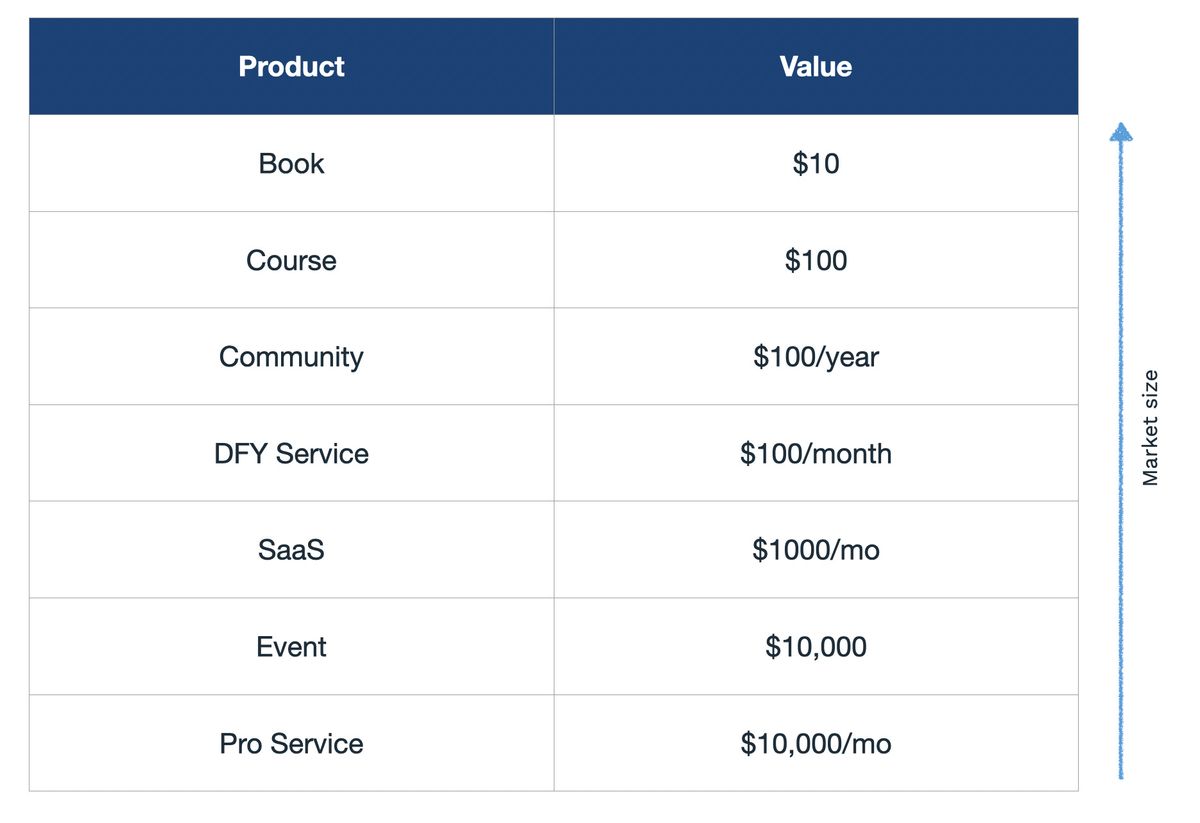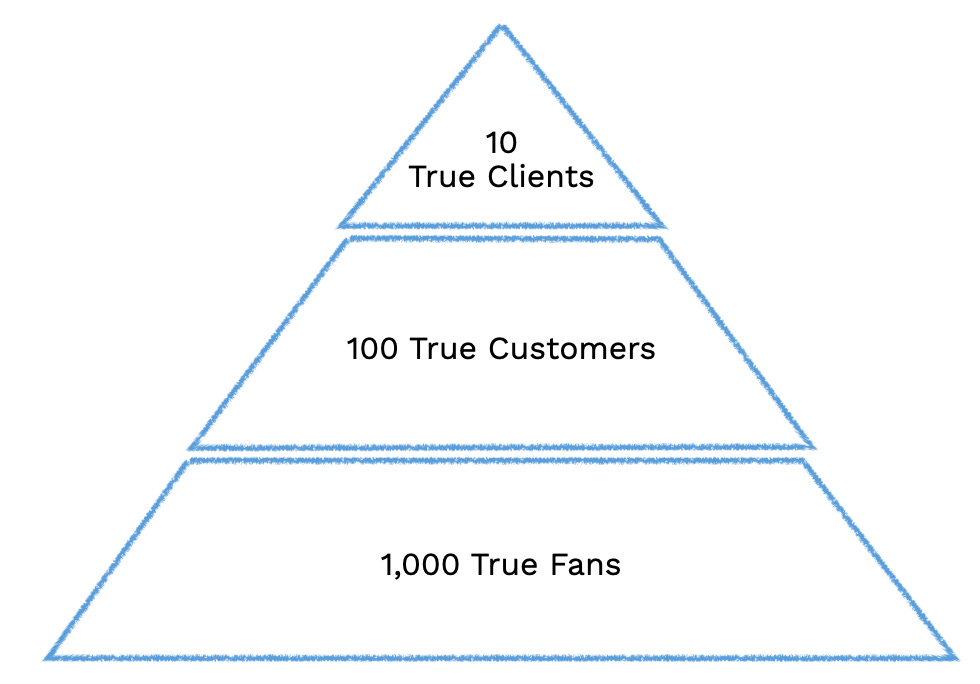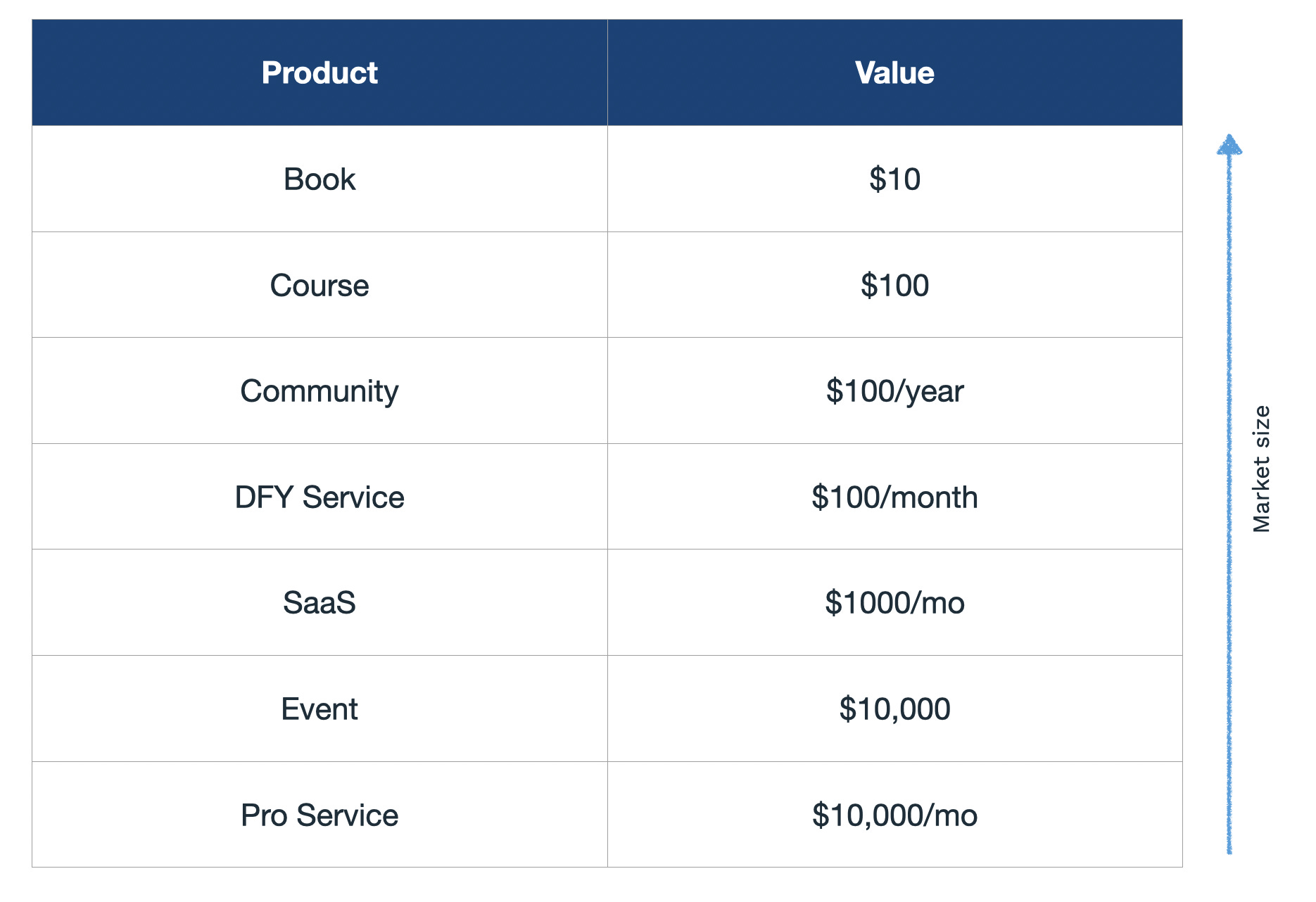The Product Pyramid
or how to not punish your customers

Most companies start with a type of product in mind.
The software developer sees every problem as something to solve with software.
The author sees every problem as something to write a book about.
The plastic surgeon sees every imperfection as something to operate on.
This approach isn’t wrong, but it can produce some catastrophic mistakes.
Seth Godin was a published author, early on the scene to the internet. When he saw this incredible thing that was about to change the world, he wrote a book that listed all the websites on the internet.
Had he instead started Yahoo!, he would be a billionaire.
A friend started an agency to help companies build SEO-optimized websites. He was absurdly early on understanding the zeitgeist of SEO and the importance of page speed. Yet he failed to seize the software opportunity, so he didn’t build the tech for a static site generator.
I’m certainly guilty of this. When I first discovered the massive blindspot in marketing, where companies fail to see their customers as the individuals who buy rather than the companies who send checks, I decided to write a white paper. It took a generous client to nudge me toward building a product instead.
If individuals fail at this, companies are often far worse.
Yahoo hit great heights, but they were always a media company at their core. When Google came along, with a tech ethos, the game ended quickly.
Toyota was early in electric cars, but couldn’t quite grasp the zeitgeist. Now Tesla is worth (at least sometimes) more than Toyota, Honda, and Volkswagen combined.
Apple had a great run, but they were slow to grasp and adapt to the right products for social networks (Facebook vs Ping), the home (Alexa vs Homepod), wearables (Oura vs Apple Watch), and autonomous navigation (Google Maps and Waymo vs Apple Maps and whatever car they have in mind.)
These companies can make these mistakes, and keep going, because the previous successes give them inertia. For a new startup or indie maker, these mistakes can lead to ruin.
The product pyramid is the mental model I use to expand my sense of freedom in making things.
Often, the same problem can be solved in a dozen ways, and keeping these options in mind will allow you to engage more of the market.
Before we look at products, though, we should start by looking at your buyers.

Many people know about Kevin Kelly’s 1,000 True Fans, in which he argues that the key for you, the artist, to thrive is simply to find 1,000 fans who will pay one day’s wages per year for your work.
If we expand this further, we get to the part that is more interesting for B2B and B2D companies.
Every problem you can solve will have a different solution for each of these tiers.
This chart gives a sense of the different possible products available for most problems you solve:

Many problems can be solved at every tier.
Most likely, the problems you solve can be solved at every tier.
Examples of this chart in action:
Tony Robbins
$10 books
$1000 seminars
$30k private retreats
Salesforce
Books, courses, community
Dreamforce event at $1,000
$1k/mo SaaS (depends on tier)
$100k Pro services to implement
FOSS model
Free community edition
Premium product tier with exclusive features
Pro services to implement
Nat Eliason
$25 for access to book notes
$100 for course on Roam
$500 for course on SEO
$5000 for services
Most companies start with the tier they find most comfortable. Two common patterns are top down and bottoms up.
Top down: the Steve Blank model for lean startup. Sell a product to one company, figure out how to make it work, keep the IP, and sell to everyone else.
Bottoms up: the Patrick McKenzie model for bootstrapping. Write the book that defines the market, establish your authority in the problem space, and move up from there.
Eventually, you should have a product at every tier. This is true because each of these products trades on information. Most of them are classic info products: books, software, courses, they all share the zero marginal cost of operations, allowing you to scale to infinity.
Professional services and events are a new kind of information product: they allow you to charge money to increase your information about the market.
When Salesforce or Amazon runs a major event for their community, they don’t just make money on the tickets or the sponsors: they gain insider information on what trends are happening adjacent to their product so they can maintain market dominance.
When a FOSS company offers customized implementations for enterprise clients, they don’t just clear a nice extra check: they get paid to sit down with clients and learn about the emerging problems in the market.
Many companies can’t afford to deliver products at every tier.
Bootstrapped companies often struggle to see the benefit of multiple products, and they feel the risk is a lack of focus. After all, those startups getting high valuations are succeeding because they are focused, right?
Funded high-growth startups, meanwhile, literally can’t afford to diversify. Companies funded on a multiple of SaaS recurring revenue have a curious property that they want to eliminate all sources of revenue that are not recurring, even if they gain massive information advantages from pro services.
I’ve seen this pattern play out a few times: SaaS company implements product to get adoption, discovers investors don’t like that, so company quickly unloads their services to anyone willing to do them. Revenue that doesn’t scale is toxic to the startup’s balance sheet.
So the secret for a bootstrapped company is this: your ability to experiment and diversify is an advantage you have over your funded competition.
While they pawn off key product tiers to adhere to the desires of investors, you can offer a breadth of services that wins more deals and keeps you in sync with the market.
While they use their next round to spend $50k on a website design and grow through paid search and other broadcast mediums, you can 10x referrals by providing more entry points to engage.
For funded startups, not all hope is lost. Perhaps you have to give up on pro services: instead, build the best event in your market (see Drift, Dreamforce) and use the access to buyers to get the best feedback.
Maybe you can’t be seen selling a book: partner with Wiley, or O’Reilly, and publish the category defining book for your market.
Maybe you can’t sell a course: find the indie consultants in your market who could produce a course, and empower them to make it happen.
Nearly every market, every problem, can be solved at every one of these tiers. The creation of a product at any given tier makes the creation of a product at every other tier easier.
If you don’t enable the creation of products for every tier in your market, you are punishing your customers, and they will notice.